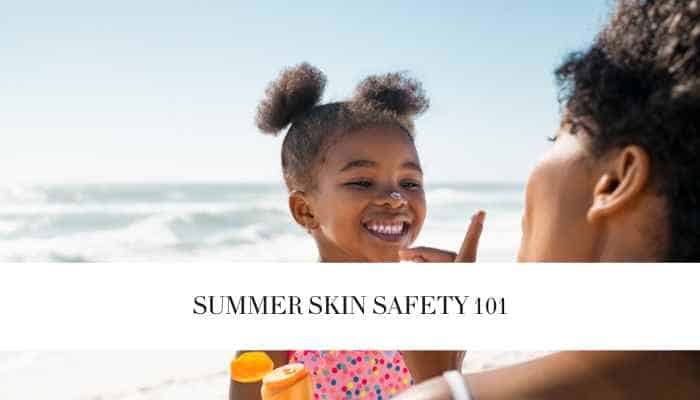Summer Skin Safety 101
By Susan “Abby” Haas, MD, pediatrician, Atrium Health Wake Forest Baptist – Brenner Children’s Hospital Pediatrics – Clemmons
With summer right around the corner, we’re all looking forward to spending more time outdoors with our families. Whether it’s a day at the pool, a neighborhood barbeque, a camping trip or simply letting your kids explore the backyard, keeping your children’s skin safe from the summer sun and bug bites is a must.
The many choices of sunscreen and insect repellents available today can be a bit puzzling. If you’re wondering what sun protection factor (SPF) works best or how to select a safe, effective bug spray, you’re not alone. Here’s a basic primer for summer skin safety so that your family can enjoy the coming months of outside fun.
Sun Protection
Multiple studies link exposure to ultraviolet rays to various types of skin cancer. With the dangers of the sun so apparent, it’s necessary to use sunscreen daily to protect children from the sun’s harmful rays. But what sunscreen should you buy and what should you look for on the label?
Last year, the Food and Drug Administration announced new standards that will apply to sunscreen products beginning this summer. Among the many changes, the new regulations include labeling products “broad spectrum” if they pass a new standard test for protection against both UVA and UVB rays. These are the rays that cause wrinkling, burning and can lead to skin cancer. Also, manufacturers can no longer claim that their sunscreens are “waterproof” or “sweatproof.” With these guidelines in place, it should be easier to navigate the many options available when shopping for sunscreen.
You can keep your children safe from the sun this summer following these easy steps:
– Start using sunscreen on children at six months of age. Infants younger than this should avoid direct sunlight and wear full coverage clothing.
– Use a sunscreen with SPF 30 or higher that is labeled” water-resistant” and “broad spectrum.”
– Apply sunscreen 30 minutes before going outside.
– Reapply sunscreen every two hours, even if it’s labeled “water-resistant.”
– When applying, use about one half ounce of sunscreen to cover your child’s body.
– Put on sunscreen before applying insect repellent, makeup or other lotions.
– Limit your child’s sun exposure between 10 am and 4 pm.
– Put a wide brim hat and sunglasses on your child and use sun protective clothing with SPF built in.
Many parents ask me whether a spray or lotion sunscreen works better. While I prefer lotions because they absorb so well, they can be harder to apply to children on the go. My best advice? Whether using a spray or lotion, be sure to apply and reapply sunscreen properly to ensure maximum protection.
It is also wise to be a good role model. Like anything we do, our children mimic our behavior. Teach them the importance of sun protection early on so that using sunscreen becomes a habit in your family before going outside.
In the event of a sunburn, have your child stay out of the sun,use aloe vera to help soothe the pain and keep your child hydrated.Contact your pediatrician if there is blistering, signs of shock or overheating, a change in mental status, severe pain or dehydration.
Insect repellent
Bugs can be serious pests during the summer months, and they also carry risk of infection and disease. Insect repellents containing the chemical DEET are considered to be the most effective at keeping bugs away and can provide protection for three to eight hours, depending on the amount of DEET in the product. The American Academy of Pediatrics recommends that repellents should contain no more than 30% DEET when used on children.
Here are a few Do’s and Don’ts to keep in mind when using insect repellent:
Do’s
– Use bug spray outdoors in a well-ventilated area.
– Spray the repellent on your hands first and then rub on your child’s skin and face, avoiding the eyes and mouth. Be sure to apply bug spray only to your child’s exposed skin, like the neck, ears, face, hands and legs.
– Spray the outside of your child’s clothes too.
– Use only as much bug spray as needed and avoid reapplying unless necessary.
– After time outside is over, clean your children’s skin with warm water and soap, and wash your children’s clothes before they are worn again.
Don’ts
– Never use bug spray on babies less than two months old.
– Repellents with DEET should not be used on wounds or cut skin.
– Don’t use a combination sunscreen and bug spray product, because sunscreen needs to be reapplied more often than bug spray.
While there are alternatives to DEET made from citronella, cedar, eucalyptus and soybean oil, these repellents are less effective and don’t last as long as DEET products. Wristbands, garlic, Vitamin B1 and devices with sound waves also offer limited protection.
Now it’s your turn to weigh in. What sunscreen and insect repellent do you prefer for your families skin safety and why?
For more information about pediatric services at Brenner Children’s Hospital, please visit us online. To make an appointment with one of our physicians, call 336-716-WAKE (9253). Click here to learn more about skin safety in the FDA’s new sunscreen guidelines.
Want to see more blogs like this and get notifications on local events in the Triad? Subscribe to TMoM’s free weekly newsletters.
You may enjoy these other blogs related to Skin Safety:
Choosing Safer Personal Care Products
Protect Yourself with Safer Sunscreen
Tossing the Toxins
Baby Skincare

